Customer Value Management Report: Analysis of Tesco's Strategies
VerifiedAdded on 2020/12/29
|11
|3798
|95
Report
AI Summary
This report provides a comprehensive analysis of Customer Value Management (CVM), using Tesco as a case study to illustrate key concepts. It delves into the components of Customer Lifetime Value (CLV), including present value, customer loyalty, and the mathematical formulas used for calculation. The report highlights the benefits of CLV for enterprises, such as enhanced goodwill and increased profitability, while also examining factors that influence CLV, like lack of professionals and competition. Furthermore, it explores market segmentation techniques applicable to a customer base, including segmentation, targeting, and positioning. The report also differentiates between B2C and B2B decision-making models and discusses various techniques to enhance customer loyalty and relationships. Overall, the report offers valuable insights into how businesses can effectively manage customer value to drive success and improve customer relationships.
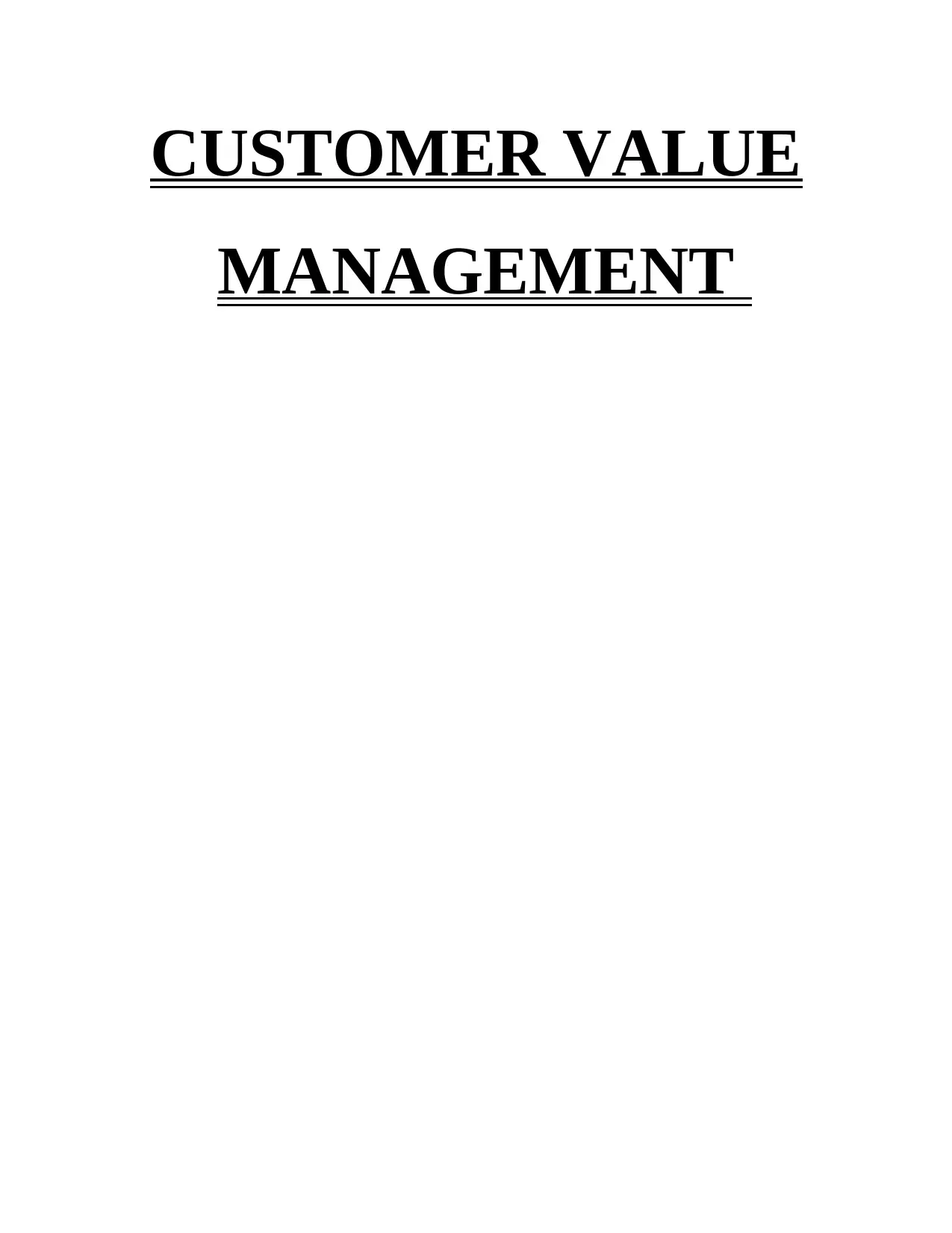
CUSTOMER VALUE
MANAGEMENT
MANAGEMENT
Paraphrase This Document
Need a fresh take? Get an instant paraphrase of this document with our AI Paraphraser
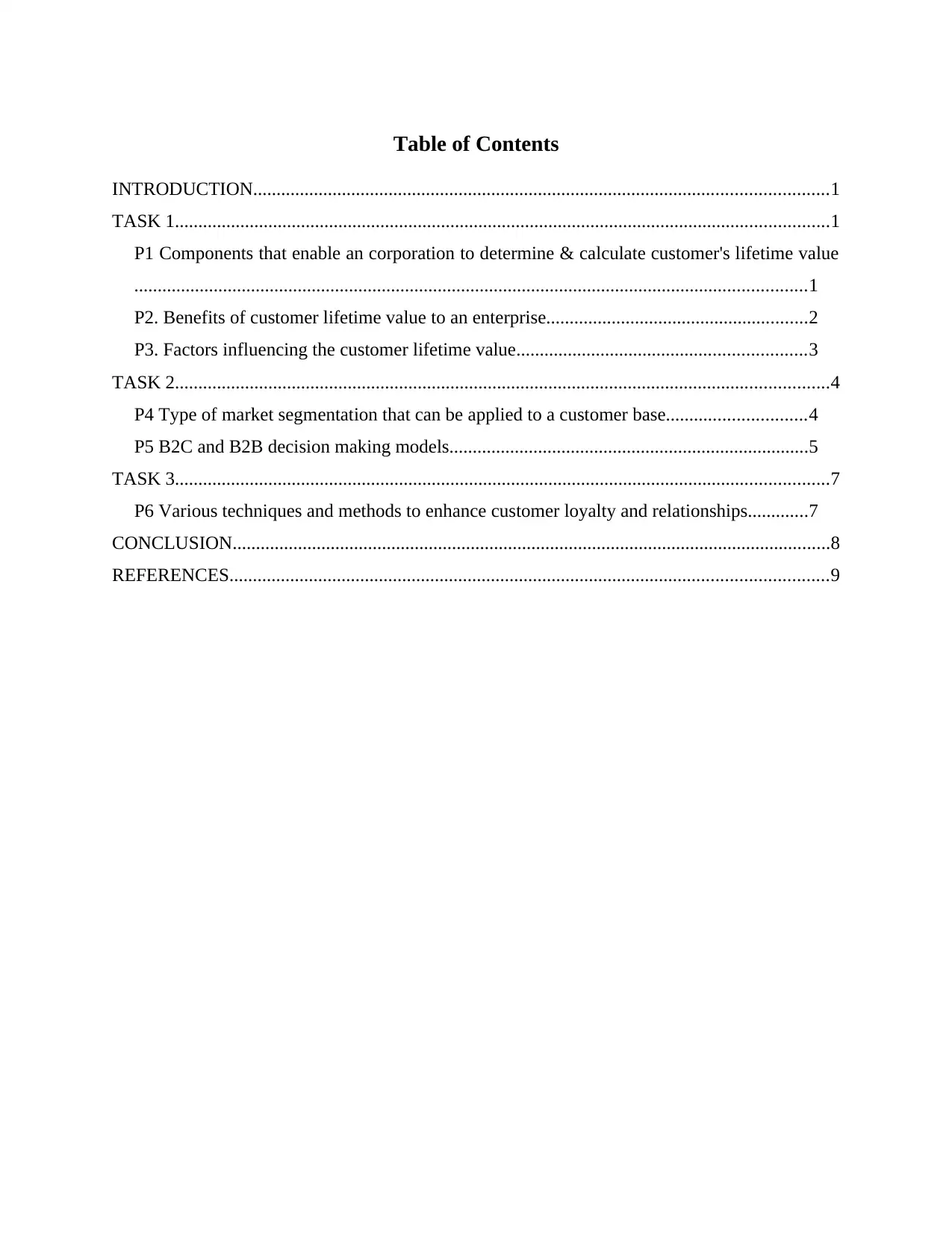
Table of Contents
INTRODUCTION...........................................................................................................................1
TASK 1............................................................................................................................................1
P1 Components that enable an corporation to determine & calculate customer's lifetime value
................................................................................................................................................1
P2. Benefits of customer lifetime value to an enterprise........................................................2
P3. Factors influencing the customer lifetime value..............................................................3
TASK 2............................................................................................................................................4
P4 Type of market segmentation that can be applied to a customer base..............................4
P5 B2C and B2B decision making models.............................................................................5
TASK 3............................................................................................................................................7
P6 Various techniques and methods to enhance customer loyalty and relationships.............7
CONCLUSION................................................................................................................................8
REFERENCES................................................................................................................................9
INTRODUCTION...........................................................................................................................1
TASK 1............................................................................................................................................1
P1 Components that enable an corporation to determine & calculate customer's lifetime value
................................................................................................................................................1
P2. Benefits of customer lifetime value to an enterprise........................................................2
P3. Factors influencing the customer lifetime value..............................................................3
TASK 2............................................................................................................................................4
P4 Type of market segmentation that can be applied to a customer base..............................4
P5 B2C and B2B decision making models.............................................................................5
TASK 3............................................................................................................................................7
P6 Various techniques and methods to enhance customer loyalty and relationships.............7
CONCLUSION................................................................................................................................8
REFERENCES................................................................................................................................9
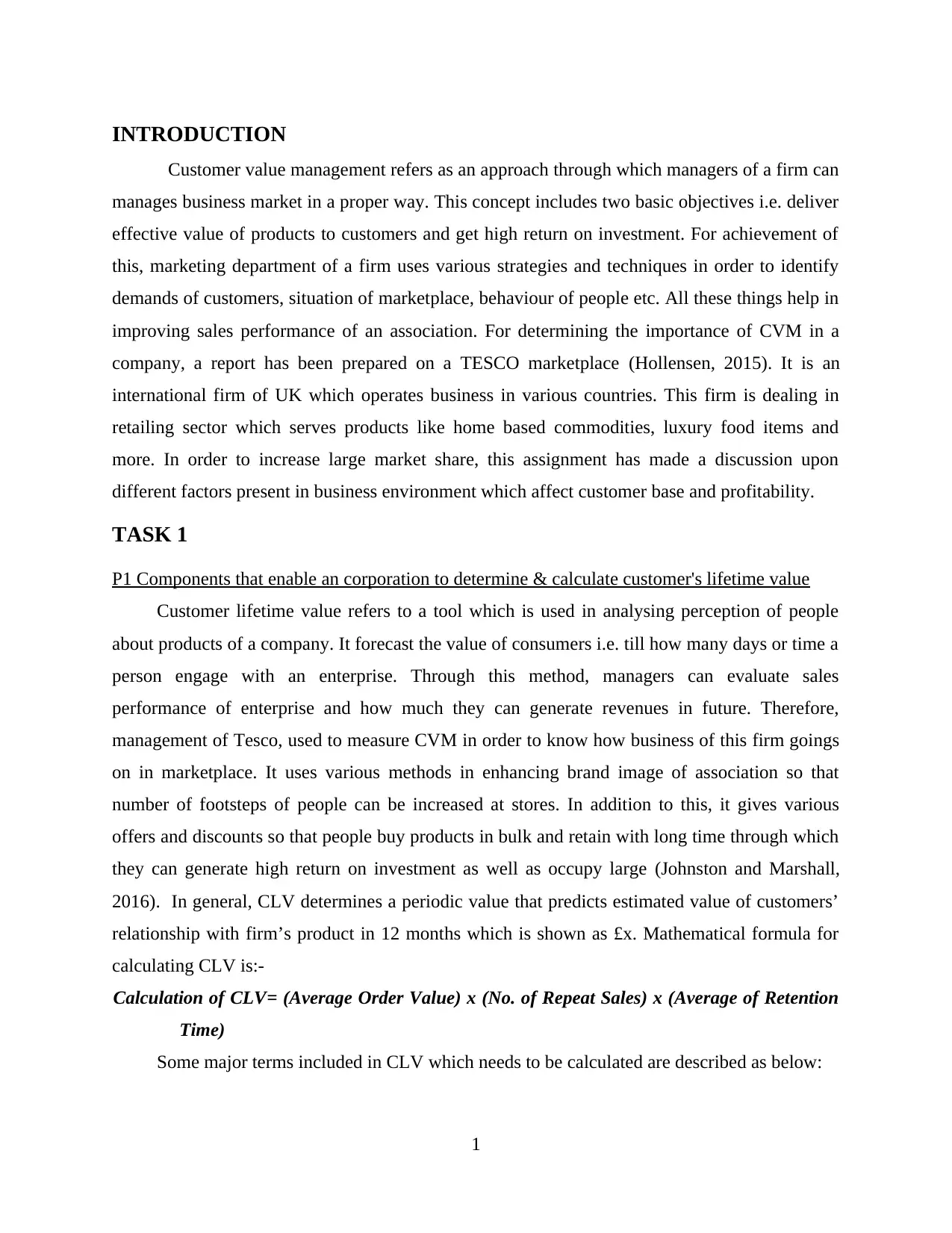
INTRODUCTION
Customer value management refers as an approach through which managers of a firm can
manages business market in a proper way. This concept includes two basic objectives i.e. deliver
effective value of products to customers and get high return on investment. For achievement of
this, marketing department of a firm uses various strategies and techniques in order to identify
demands of customers, situation of marketplace, behaviour of people etc. All these things help in
improving sales performance of an association. For determining the importance of CVM in a
company, a report has been prepared on a TESCO marketplace (Hollensen, 2015). It is an
international firm of UK which operates business in various countries. This firm is dealing in
retailing sector which serves products like home based commodities, luxury food items and
more. In order to increase large market share, this assignment has made a discussion upon
different factors present in business environment which affect customer base and profitability.
TASK 1
P1 Components that enable an corporation to determine & calculate customer's lifetime value
Customer lifetime value refers to a tool which is used in analysing perception of people
about products of a company. It forecast the value of consumers i.e. till how many days or time a
person engage with an enterprise. Through this method, managers can evaluate sales
performance of enterprise and how much they can generate revenues in future. Therefore,
management of Tesco, used to measure CVM in order to know how business of this firm goings
on in marketplace. It uses various methods in enhancing brand image of association so that
number of footsteps of people can be increased at stores. In addition to this, it gives various
offers and discounts so that people buy products in bulk and retain with long time through which
they can generate high return on investment as well as occupy large (Johnston and Marshall,
2016). In general, CLV determines a periodic value that predicts estimated value of customers’
relationship with firm’s product in 12 months which is shown as £x. Mathematical formula for
calculating CLV is:-
Calculation of CLV= (Average Order Value) x (No. of Repeat Sales) x (Average of Retention
Time)
Some major terms included in CLV which needs to be calculated are described as below:
1
Customer value management refers as an approach through which managers of a firm can
manages business market in a proper way. This concept includes two basic objectives i.e. deliver
effective value of products to customers and get high return on investment. For achievement of
this, marketing department of a firm uses various strategies and techniques in order to identify
demands of customers, situation of marketplace, behaviour of people etc. All these things help in
improving sales performance of an association. For determining the importance of CVM in a
company, a report has been prepared on a TESCO marketplace (Hollensen, 2015). It is an
international firm of UK which operates business in various countries. This firm is dealing in
retailing sector which serves products like home based commodities, luxury food items and
more. In order to increase large market share, this assignment has made a discussion upon
different factors present in business environment which affect customer base and profitability.
TASK 1
P1 Components that enable an corporation to determine & calculate customer's lifetime value
Customer lifetime value refers to a tool which is used in analysing perception of people
about products of a company. It forecast the value of consumers i.e. till how many days or time a
person engage with an enterprise. Through this method, managers can evaluate sales
performance of enterprise and how much they can generate revenues in future. Therefore,
management of Tesco, used to measure CVM in order to know how business of this firm goings
on in marketplace. It uses various methods in enhancing brand image of association so that
number of footsteps of people can be increased at stores. In addition to this, it gives various
offers and discounts so that people buy products in bulk and retain with long time through which
they can generate high return on investment as well as occupy large (Johnston and Marshall,
2016). In general, CLV determines a periodic value that predicts estimated value of customers’
relationship with firm’s product in 12 months which is shown as £x. Mathematical formula for
calculating CLV is:-
Calculation of CLV= (Average Order Value) x (No. of Repeat Sales) x (Average of Retention
Time)
Some major terms included in CLV which needs to be calculated are described as below:
1
⊘ This is a preview!⊘
Do you want full access?
Subscribe today to unlock all pages.

Trusted by 1+ million students worldwide
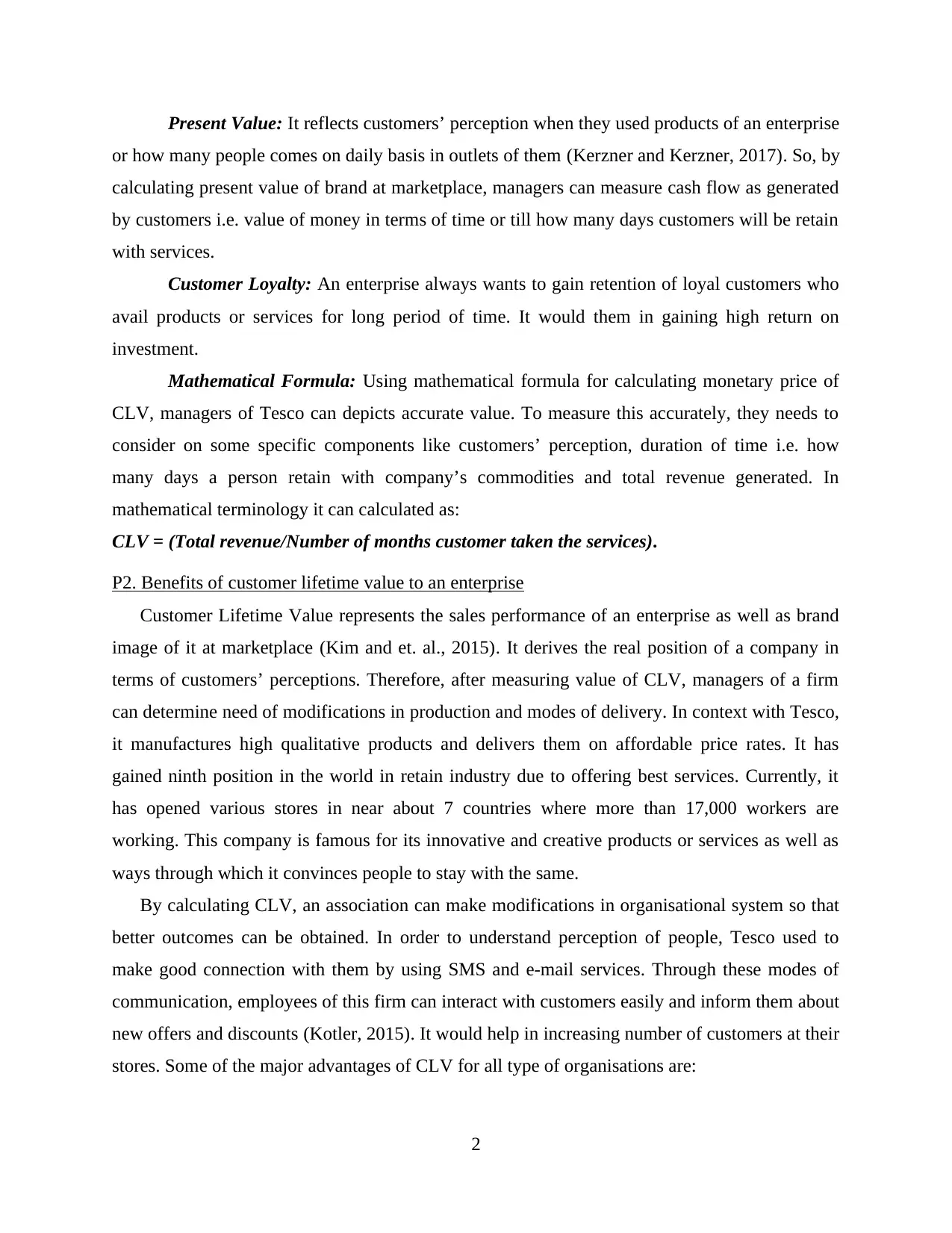
Present Value: It reflects customers’ perception when they used products of an enterprise
or how many people comes on daily basis in outlets of them (Kerzner and Kerzner, 2017). So, by
calculating present value of brand at marketplace, managers can measure cash flow as generated
by customers i.e. value of money in terms of time or till how many days customers will be retain
with services.
Customer Loyalty: An enterprise always wants to gain retention of loyal customers who
avail products or services for long period of time. It would them in gaining high return on
investment.
Mathematical Formula: Using mathematical formula for calculating monetary price of
CLV, managers of Tesco can depicts accurate value. To measure this accurately, they needs to
consider on some specific components like customers’ perception, duration of time i.e. how
many days a person retain with company’s commodities and total revenue generated. In
mathematical terminology it can calculated as:
CLV = (Total revenue/Number of months customer taken the services).
P2. Benefits of customer lifetime value to an enterprise
Customer Lifetime Value represents the sales performance of an enterprise as well as brand
image of it at marketplace (Kim and et. al., 2015). It derives the real position of a company in
terms of customers’ perceptions. Therefore, after measuring value of CLV, managers of a firm
can determine need of modifications in production and modes of delivery. In context with Tesco,
it manufactures high qualitative products and delivers them on affordable price rates. It has
gained ninth position in the world in retain industry due to offering best services. Currently, it
has opened various stores in near about 7 countries where more than 17,000 workers are
working. This company is famous for its innovative and creative products or services as well as
ways through which it convinces people to stay with the same.
By calculating CLV, an association can make modifications in organisational system so that
better outcomes can be obtained. In order to understand perception of people, Tesco used to
make good connection with them by using SMS and e-mail services. Through these modes of
communication, employees of this firm can interact with customers easily and inform them about
new offers and discounts (Kotler, 2015). It would help in increasing number of customers at their
stores. Some of the major advantages of CLV for all type of organisations are:
2
or how many people comes on daily basis in outlets of them (Kerzner and Kerzner, 2017). So, by
calculating present value of brand at marketplace, managers can measure cash flow as generated
by customers i.e. value of money in terms of time or till how many days customers will be retain
with services.
Customer Loyalty: An enterprise always wants to gain retention of loyal customers who
avail products or services for long period of time. It would them in gaining high return on
investment.
Mathematical Formula: Using mathematical formula for calculating monetary price of
CLV, managers of Tesco can depicts accurate value. To measure this accurately, they needs to
consider on some specific components like customers’ perception, duration of time i.e. how
many days a person retain with company’s commodities and total revenue generated. In
mathematical terminology it can calculated as:
CLV = (Total revenue/Number of months customer taken the services).
P2. Benefits of customer lifetime value to an enterprise
Customer Lifetime Value represents the sales performance of an enterprise as well as brand
image of it at marketplace (Kim and et. al., 2015). It derives the real position of a company in
terms of customers’ perceptions. Therefore, after measuring value of CLV, managers of a firm
can determine need of modifications in production and modes of delivery. In context with Tesco,
it manufactures high qualitative products and delivers them on affordable price rates. It has
gained ninth position in the world in retain industry due to offering best services. Currently, it
has opened various stores in near about 7 countries where more than 17,000 workers are
working. This company is famous for its innovative and creative products or services as well as
ways through which it convinces people to stay with the same.
By calculating CLV, an association can make modifications in organisational system so that
better outcomes can be obtained. In order to understand perception of people, Tesco used to
make good connection with them by using SMS and e-mail services. Through these modes of
communication, employees of this firm can interact with customers easily and inform them about
new offers and discounts (Kotler, 2015). It would help in increasing number of customers at their
stores. Some of the major advantages of CLV for all type of organisations are:
2
Paraphrase This Document
Need a fresh take? Get an instant paraphrase of this document with our AI Paraphraser
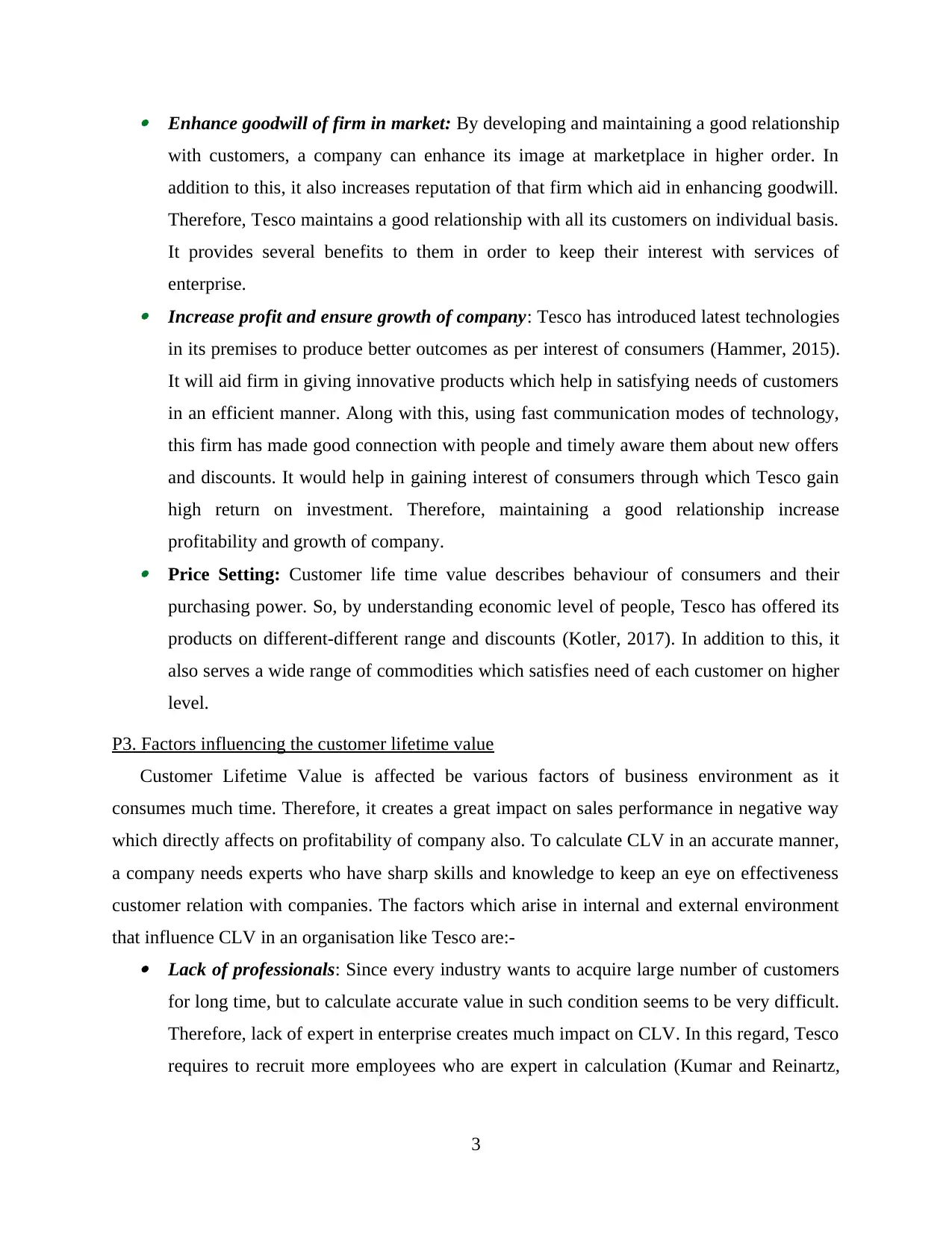
Enhance goodwill of firm in market: By developing and maintaining a good relationship
with customers, a company can enhance its image at marketplace in higher order. In
addition to this, it also increases reputation of that firm which aid in enhancing goodwill.
Therefore, Tesco maintains a good relationship with all its customers on individual basis.
It provides several benefits to them in order to keep their interest with services of
enterprise. Increase profit and ensure growth of company: Tesco has introduced latest technologies
in its premises to produce better outcomes as per interest of consumers (Hammer, 2015).
It will aid firm in giving innovative products which help in satisfying needs of customers
in an efficient manner. Along with this, using fast communication modes of technology,
this firm has made good connection with people and timely aware them about new offers
and discounts. It would help in gaining interest of consumers through which Tesco gain
high return on investment. Therefore, maintaining a good relationship increase
profitability and growth of company. Price Setting: Customer life time value describes behaviour of consumers and their
purchasing power. So, by understanding economic level of people, Tesco has offered its
products on different-different range and discounts (Kotler, 2017). In addition to this, it
also serves a wide range of commodities which satisfies need of each customer on higher
level.
P3. Factors influencing the customer lifetime value
Customer Lifetime Value is affected be various factors of business environment as it
consumes much time. Therefore, it creates a great impact on sales performance in negative way
which directly affects on profitability of company also. To calculate CLV in an accurate manner,
a company needs experts who have sharp skills and knowledge to keep an eye on effectiveness
customer relation with companies. The factors which arise in internal and external environment
that influence CLV in an organisation like Tesco are:- Lack of professionals: Since every industry wants to acquire large number of customers
for long time, but to calculate accurate value in such condition seems to be very difficult.
Therefore, lack of expert in enterprise creates much impact on CLV. In this regard, Tesco
requires to recruit more employees who are expert in calculation (Kumar and Reinartz,
3
with customers, a company can enhance its image at marketplace in higher order. In
addition to this, it also increases reputation of that firm which aid in enhancing goodwill.
Therefore, Tesco maintains a good relationship with all its customers on individual basis.
It provides several benefits to them in order to keep their interest with services of
enterprise. Increase profit and ensure growth of company: Tesco has introduced latest technologies
in its premises to produce better outcomes as per interest of consumers (Hammer, 2015).
It will aid firm in giving innovative products which help in satisfying needs of customers
in an efficient manner. Along with this, using fast communication modes of technology,
this firm has made good connection with people and timely aware them about new offers
and discounts. It would help in gaining interest of consumers through which Tesco gain
high return on investment. Therefore, maintaining a good relationship increase
profitability and growth of company. Price Setting: Customer life time value describes behaviour of consumers and their
purchasing power. So, by understanding economic level of people, Tesco has offered its
products on different-different range and discounts (Kotler, 2017). In addition to this, it
also serves a wide range of commodities which satisfies need of each customer on higher
level.
P3. Factors influencing the customer lifetime value
Customer Lifetime Value is affected be various factors of business environment as it
consumes much time. Therefore, it creates a great impact on sales performance in negative way
which directly affects on profitability of company also. To calculate CLV in an accurate manner,
a company needs experts who have sharp skills and knowledge to keep an eye on effectiveness
customer relation with companies. The factors which arise in internal and external environment
that influence CLV in an organisation like Tesco are:- Lack of professionals: Since every industry wants to acquire large number of customers
for long time, but to calculate accurate value in such condition seems to be very difficult.
Therefore, lack of expert in enterprise creates much impact on CLV. In this regard, Tesco
requires to recruit more employees who are expert in calculation (Kumar and Reinartz,
3
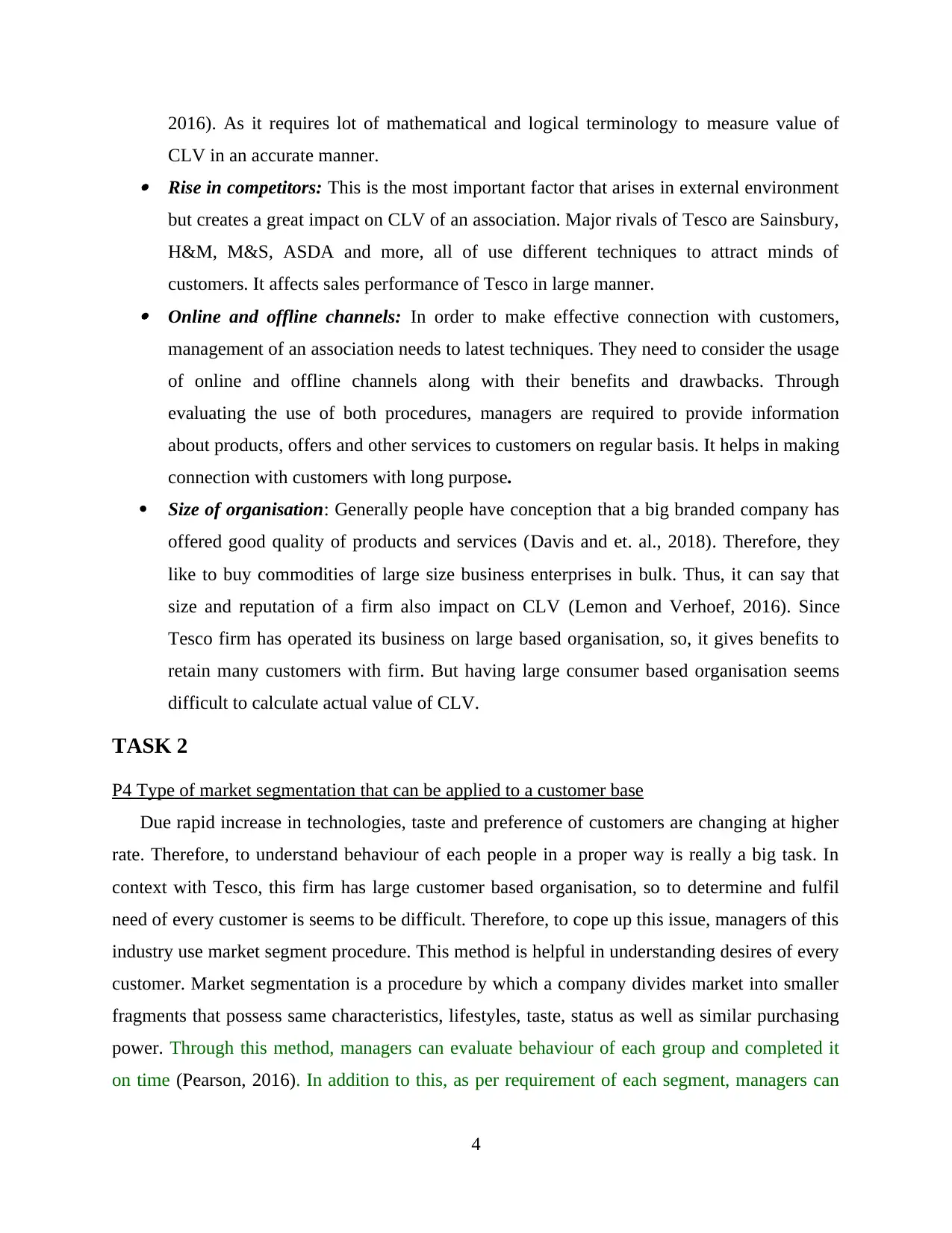
2016). As it requires lot of mathematical and logical terminology to measure value of
CLV in an accurate manner. Rise in competitors: This is the most important factor that arises in external environment
but creates a great impact on CLV of an association. Major rivals of Tesco are Sainsbury,
H&M, M&S, ASDA and more, all of use different techniques to attract minds of
customers. It affects sales performance of Tesco in large manner. Online and offline channels: In order to make effective connection with customers,
management of an association needs to latest techniques. They need to consider the usage
of online and offline channels along with their benefits and drawbacks. Through
evaluating the use of both procedures, managers are required to provide information
about products, offers and other services to customers on regular basis. It helps in making
connection with customers with long purpose.
Size of organisation: Generally people have conception that a big branded company has
offered good quality of products and services (Davis and et. al., 2018). Therefore, they
like to buy commodities of large size business enterprises in bulk. Thus, it can say that
size and reputation of a firm also impact on CLV (Lemon and Verhoef, 2016). Since
Tesco firm has operated its business on large based organisation, so, it gives benefits to
retain many customers with firm. But having large consumer based organisation seems
difficult to calculate actual value of CLV.
TASK 2
P4 Type of market segmentation that can be applied to a customer base
Due rapid increase in technologies, taste and preference of customers are changing at higher
rate. Therefore, to understand behaviour of each people in a proper way is really a big task. In
context with Tesco, this firm has large customer based organisation, so to determine and fulfil
need of every customer is seems to be difficult. Therefore, to cope up this issue, managers of this
industry use market segment procedure. This method is helpful in understanding desires of every
customer. Market segmentation is a procedure by which a company divides market into smaller
fragments that possess same characteristics, lifestyles, taste, status as well as similar purchasing
power. Through this method, managers can evaluate behaviour of each group and completed it
on time (Pearson, 2016). In addition to this, as per requirement of each segment, managers can
4
CLV in an accurate manner. Rise in competitors: This is the most important factor that arises in external environment
but creates a great impact on CLV of an association. Major rivals of Tesco are Sainsbury,
H&M, M&S, ASDA and more, all of use different techniques to attract minds of
customers. It affects sales performance of Tesco in large manner. Online and offline channels: In order to make effective connection with customers,
management of an association needs to latest techniques. They need to consider the usage
of online and offline channels along with their benefits and drawbacks. Through
evaluating the use of both procedures, managers are required to provide information
about products, offers and other services to customers on regular basis. It helps in making
connection with customers with long purpose.
Size of organisation: Generally people have conception that a big branded company has
offered good quality of products and services (Davis and et. al., 2018). Therefore, they
like to buy commodities of large size business enterprises in bulk. Thus, it can say that
size and reputation of a firm also impact on CLV (Lemon and Verhoef, 2016). Since
Tesco firm has operated its business on large based organisation, so, it gives benefits to
retain many customers with firm. But having large consumer based organisation seems
difficult to calculate actual value of CLV.
TASK 2
P4 Type of market segmentation that can be applied to a customer base
Due rapid increase in technologies, taste and preference of customers are changing at higher
rate. Therefore, to understand behaviour of each people in a proper way is really a big task. In
context with Tesco, this firm has large customer based organisation, so to determine and fulfil
need of every customer is seems to be difficult. Therefore, to cope up this issue, managers of this
industry use market segment procedure. This method is helpful in understanding desires of every
customer. Market segmentation is a procedure by which a company divides market into smaller
fragments that possess same characteristics, lifestyles, taste, status as well as similar purchasing
power. Through this method, managers can evaluate behaviour of each group and completed it
on time (Pearson, 2016). In addition to this, as per requirement of each segment, managers can
4
⊘ This is a preview!⊘
Do you want full access?
Subscribe today to unlock all pages.

Trusted by 1+ million students worldwide
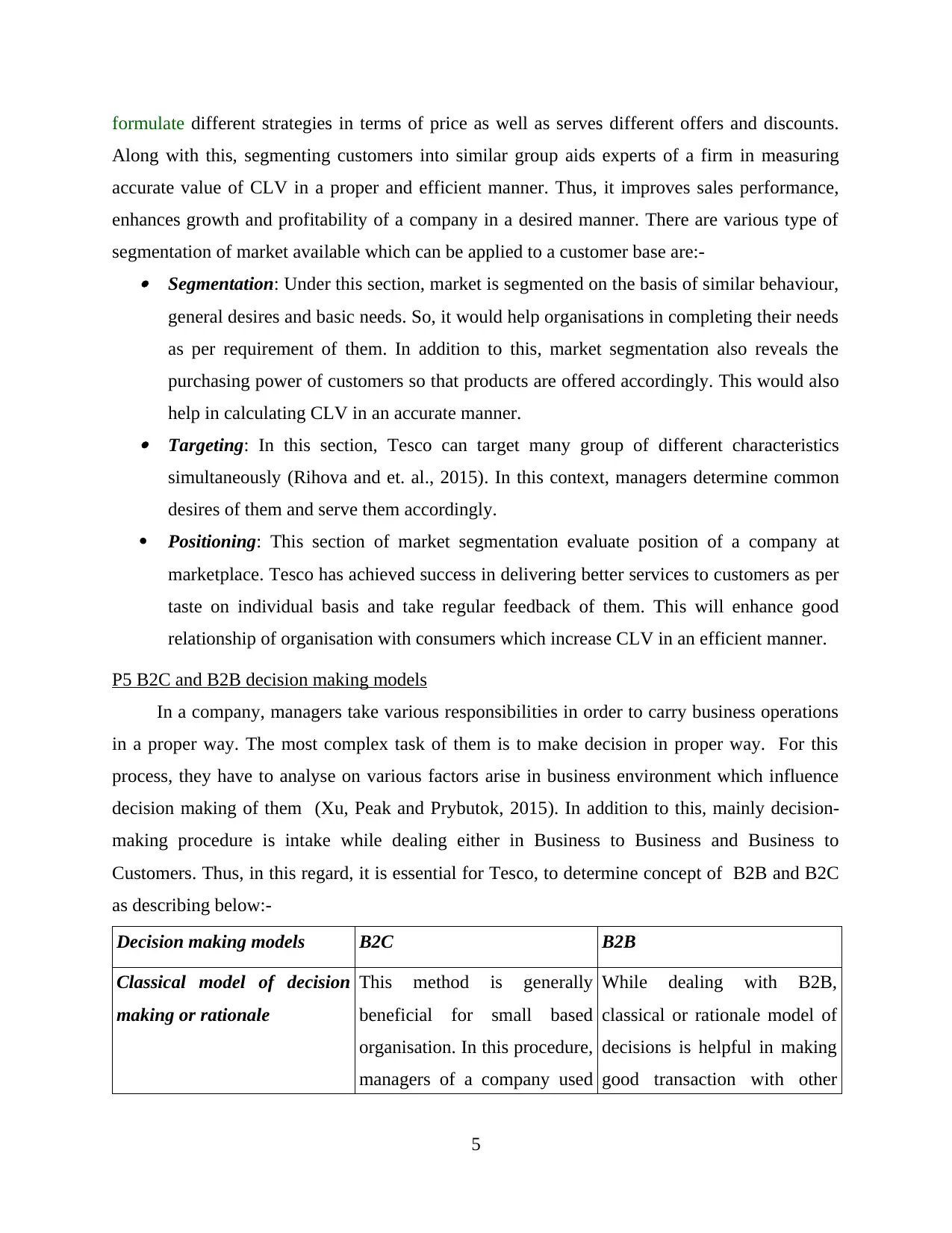
formulate different strategies in terms of price as well as serves different offers and discounts.
Along with this, segmenting customers into similar group aids experts of a firm in measuring
accurate value of CLV in a proper and efficient manner. Thus, it improves sales performance,
enhances growth and profitability of a company in a desired manner. There are various type of
segmentation of market available which can be applied to a customer base are:- Segmentation: Under this section, market is segmented on the basis of similar behaviour,
general desires and basic needs. So, it would help organisations in completing their needs
as per requirement of them. In addition to this, market segmentation also reveals the
purchasing power of customers so that products are offered accordingly. This would also
help in calculating CLV in an accurate manner. Targeting: In this section, Tesco can target many group of different characteristics
simultaneously (Rihova and et. al., 2015). In this context, managers determine common
desires of them and serve them accordingly.
Positioning: This section of market segmentation evaluate position of a company at
marketplace. Tesco has achieved success in delivering better services to customers as per
taste on individual basis and take regular feedback of them. This will enhance good
relationship of organisation with consumers which increase CLV in an efficient manner.
P5 B2C and B2B decision making models
In a company, managers take various responsibilities in order to carry business operations
in a proper way. The most complex task of them is to make decision in proper way. For this
process, they have to analyse on various factors arise in business environment which influence
decision making of them (Xu, Peak and Prybutok, 2015). In addition to this, mainly decision-
making procedure is intake while dealing either in Business to Business and Business to
Customers. Thus, in this regard, it is essential for Tesco, to determine concept of B2B and B2C
as describing below:-
Decision making models B2C B2B
Classical model of decision
making or rationale
This method is generally
beneficial for small based
organisation. In this procedure,
managers of a company used
While dealing with B2B,
classical or rationale model of
decisions is helpful in making
good transaction with other
5
Along with this, segmenting customers into similar group aids experts of a firm in measuring
accurate value of CLV in a proper and efficient manner. Thus, it improves sales performance,
enhances growth and profitability of a company in a desired manner. There are various type of
segmentation of market available which can be applied to a customer base are:- Segmentation: Under this section, market is segmented on the basis of similar behaviour,
general desires and basic needs. So, it would help organisations in completing their needs
as per requirement of them. In addition to this, market segmentation also reveals the
purchasing power of customers so that products are offered accordingly. This would also
help in calculating CLV in an accurate manner. Targeting: In this section, Tesco can target many group of different characteristics
simultaneously (Rihova and et. al., 2015). In this context, managers determine common
desires of them and serve them accordingly.
Positioning: This section of market segmentation evaluate position of a company at
marketplace. Tesco has achieved success in delivering better services to customers as per
taste on individual basis and take regular feedback of them. This will enhance good
relationship of organisation with consumers which increase CLV in an efficient manner.
P5 B2C and B2B decision making models
In a company, managers take various responsibilities in order to carry business operations
in a proper way. The most complex task of them is to make decision in proper way. For this
process, they have to analyse on various factors arise in business environment which influence
decision making of them (Xu, Peak and Prybutok, 2015). In addition to this, mainly decision-
making procedure is intake while dealing either in Business to Business and Business to
Customers. Thus, in this regard, it is essential for Tesco, to determine concept of B2B and B2C
as describing below:-
Decision making models B2C B2B
Classical model of decision
making or rationale
This method is generally
beneficial for small based
organisation. In this procedure,
managers of a company used
While dealing with B2B,
classical or rationale model of
decisions is helpful in making
good transaction with other
5
Paraphrase This Document
Need a fresh take? Get an instant paraphrase of this document with our AI Paraphraser
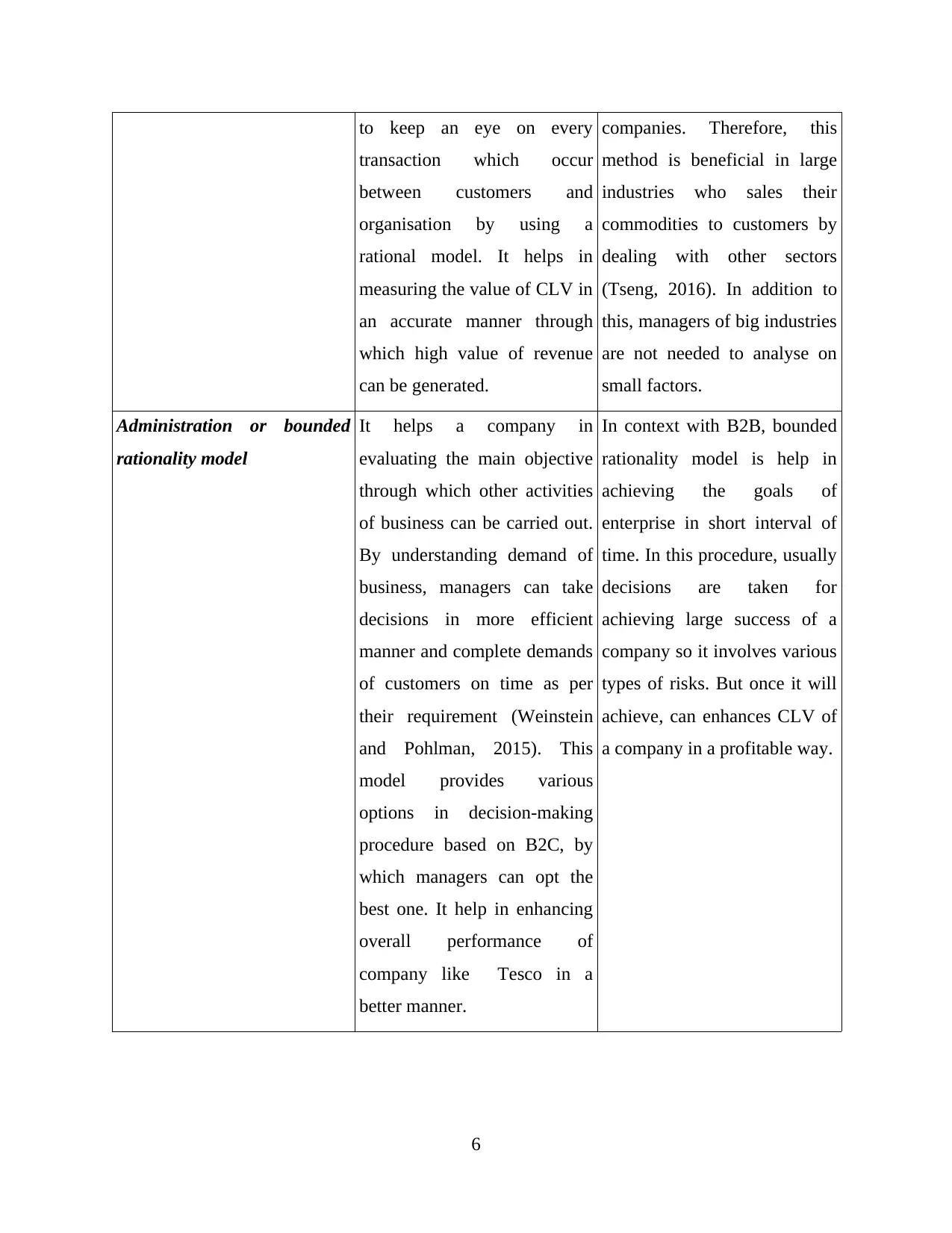
to keep an eye on every
transaction which occur
between customers and
organisation by using a
rational model. It helps in
measuring the value of CLV in
an accurate manner through
which high value of revenue
can be generated.
companies. Therefore, this
method is beneficial in large
industries who sales their
commodities to customers by
dealing with other sectors
(Tseng, 2016). In addition to
this, managers of big industries
are not needed to analyse on
small factors.
Administration or bounded
rationality model
It helps a company in
evaluating the main objective
through which other activities
of business can be carried out.
By understanding demand of
business, managers can take
decisions in more efficient
manner and complete demands
of customers on time as per
their requirement (Weinstein
and Pohlman, 2015). This
model provides various
options in decision-making
procedure based on B2C, by
which managers can opt the
best one. It help in enhancing
overall performance of
company like Tesco in a
better manner.
In context with B2B, bounded
rationality model is help in
achieving the goals of
enterprise in short interval of
time. In this procedure, usually
decisions are taken for
achieving large success of a
company so it involves various
types of risks. But once it will
achieve, can enhances CLV of
a company in a profitable way.
6
transaction which occur
between customers and
organisation by using a
rational model. It helps in
measuring the value of CLV in
an accurate manner through
which high value of revenue
can be generated.
companies. Therefore, this
method is beneficial in large
industries who sales their
commodities to customers by
dealing with other sectors
(Tseng, 2016). In addition to
this, managers of big industries
are not needed to analyse on
small factors.
Administration or bounded
rationality model
It helps a company in
evaluating the main objective
through which other activities
of business can be carried out.
By understanding demand of
business, managers can take
decisions in more efficient
manner and complete demands
of customers on time as per
their requirement (Weinstein
and Pohlman, 2015). This
model provides various
options in decision-making
procedure based on B2C, by
which managers can opt the
best one. It help in enhancing
overall performance of
company like Tesco in a
better manner.
In context with B2B, bounded
rationality model is help in
achieving the goals of
enterprise in short interval of
time. In this procedure, usually
decisions are taken for
achieving large success of a
company so it involves various
types of risks. But once it will
achieve, can enhances CLV of
a company in a profitable way.
6
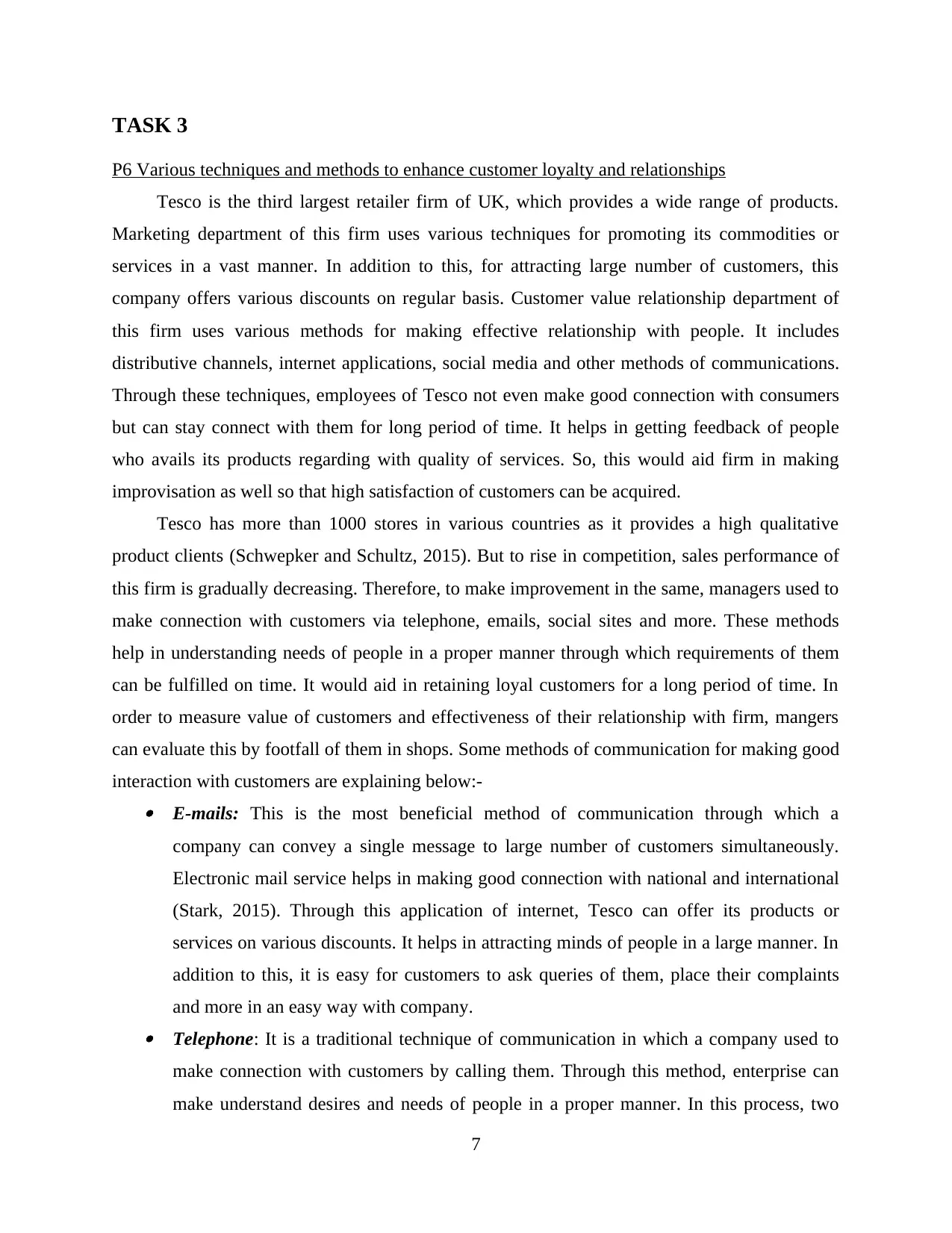
TASK 3
P6 Various techniques and methods to enhance customer loyalty and relationships
Tesco is the third largest retailer firm of UK, which provides a wide range of products.
Marketing department of this firm uses various techniques for promoting its commodities or
services in a vast manner. In addition to this, for attracting large number of customers, this
company offers various discounts on regular basis. Customer value relationship department of
this firm uses various methods for making effective relationship with people. It includes
distributive channels, internet applications, social media and other methods of communications.
Through these techniques, employees of Tesco not even make good connection with consumers
but can stay connect with them for long period of time. It helps in getting feedback of people
who avails its products regarding with quality of services. So, this would aid firm in making
improvisation as well so that high satisfaction of customers can be acquired.
Tesco has more than 1000 stores in various countries as it provides a high qualitative
product clients (Schwepker and Schultz, 2015). But to rise in competition, sales performance of
this firm is gradually decreasing. Therefore, to make improvement in the same, managers used to
make connection with customers via telephone, emails, social sites and more. These methods
help in understanding needs of people in a proper manner through which requirements of them
can be fulfilled on time. It would aid in retaining loyal customers for a long period of time. In
order to measure value of customers and effectiveness of their relationship with firm, mangers
can evaluate this by footfall of them in shops. Some methods of communication for making good
interaction with customers are explaining below:- E-mails: This is the most beneficial method of communication through which a
company can convey a single message to large number of customers simultaneously.
Electronic mail service helps in making good connection with national and international
(Stark, 2015). Through this application of internet, Tesco can offer its products or
services on various discounts. It helps in attracting minds of people in a large manner. In
addition to this, it is easy for customers to ask queries of them, place their complaints
and more in an easy way with company. Telephone: It is a traditional technique of communication in which a company used to
make connection with customers by calling them. Through this method, enterprise can
make understand desires and needs of people in a proper manner. In this process, two
7
P6 Various techniques and methods to enhance customer loyalty and relationships
Tesco is the third largest retailer firm of UK, which provides a wide range of products.
Marketing department of this firm uses various techniques for promoting its commodities or
services in a vast manner. In addition to this, for attracting large number of customers, this
company offers various discounts on regular basis. Customer value relationship department of
this firm uses various methods for making effective relationship with people. It includes
distributive channels, internet applications, social media and other methods of communications.
Through these techniques, employees of Tesco not even make good connection with consumers
but can stay connect with them for long period of time. It helps in getting feedback of people
who avails its products regarding with quality of services. So, this would aid firm in making
improvisation as well so that high satisfaction of customers can be acquired.
Tesco has more than 1000 stores in various countries as it provides a high qualitative
product clients (Schwepker and Schultz, 2015). But to rise in competition, sales performance of
this firm is gradually decreasing. Therefore, to make improvement in the same, managers used to
make connection with customers via telephone, emails, social sites and more. These methods
help in understanding needs of people in a proper manner through which requirements of them
can be fulfilled on time. It would aid in retaining loyal customers for a long period of time. In
order to measure value of customers and effectiveness of their relationship with firm, mangers
can evaluate this by footfall of them in shops. Some methods of communication for making good
interaction with customers are explaining below:- E-mails: This is the most beneficial method of communication through which a
company can convey a single message to large number of customers simultaneously.
Electronic mail service helps in making good connection with national and international
(Stark, 2015). Through this application of internet, Tesco can offer its products or
services on various discounts. It helps in attracting minds of people in a large manner. In
addition to this, it is easy for customers to ask queries of them, place their complaints
and more in an easy way with company. Telephone: It is a traditional technique of communication in which a company used to
make connection with customers by calling them. Through this method, enterprise can
make understand desires and needs of people in a proper manner. In this process, two
7
⊘ This is a preview!⊘
Do you want full access?
Subscribe today to unlock all pages.

Trusted by 1+ million students worldwide
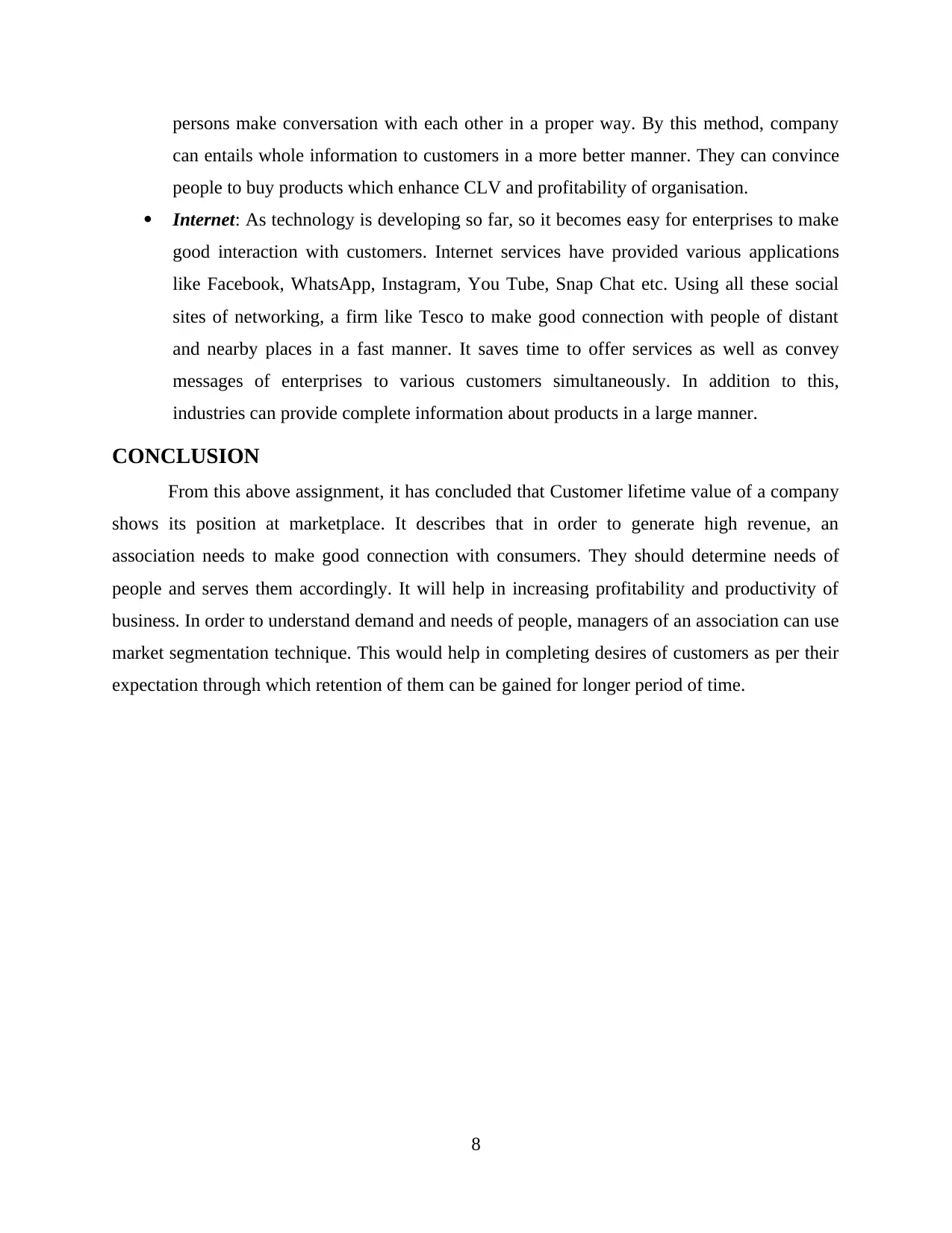
persons make conversation with each other in a proper way. By this method, company
can entails whole information to customers in a more better manner. They can convince
people to buy products which enhance CLV and profitability of organisation.
Internet: As technology is developing so far, so it becomes easy for enterprises to make
good interaction with customers. Internet services have provided various applications
like Facebook, WhatsApp, Instagram, You Tube, Snap Chat etc. Using all these social
sites of networking, a firm like Tesco to make good connection with people of distant
and nearby places in a fast manner. It saves time to offer services as well as convey
messages of enterprises to various customers simultaneously. In addition to this,
industries can provide complete information about products in a large manner.
CONCLUSION
From this above assignment, it has concluded that Customer lifetime value of a company
shows its position at marketplace. It describes that in order to generate high revenue, an
association needs to make good connection with consumers. They should determine needs of
people and serves them accordingly. It will help in increasing profitability and productivity of
business. In order to understand demand and needs of people, managers of an association can use
market segmentation technique. This would help in completing desires of customers as per their
expectation through which retention of them can be gained for longer period of time.
8
can entails whole information to customers in a more better manner. They can convince
people to buy products which enhance CLV and profitability of organisation.
Internet: As technology is developing so far, so it becomes easy for enterprises to make
good interaction with customers. Internet services have provided various applications
like Facebook, WhatsApp, Instagram, You Tube, Snap Chat etc. Using all these social
sites of networking, a firm like Tesco to make good connection with people of distant
and nearby places in a fast manner. It saves time to offer services as well as convey
messages of enterprises to various customers simultaneously. In addition to this,
industries can provide complete information about products in a large manner.
CONCLUSION
From this above assignment, it has concluded that Customer lifetime value of a company
shows its position at marketplace. It describes that in order to generate high revenue, an
association needs to make good connection with consumers. They should determine needs of
people and serves them accordingly. It will help in increasing profitability and productivity of
business. In order to understand demand and needs of people, managers of an association can use
market segmentation technique. This would help in completing desires of customers as per their
expectation through which retention of them can be gained for longer period of time.
8
Paraphrase This Document
Need a fresh take? Get an instant paraphrase of this document with our AI Paraphraser
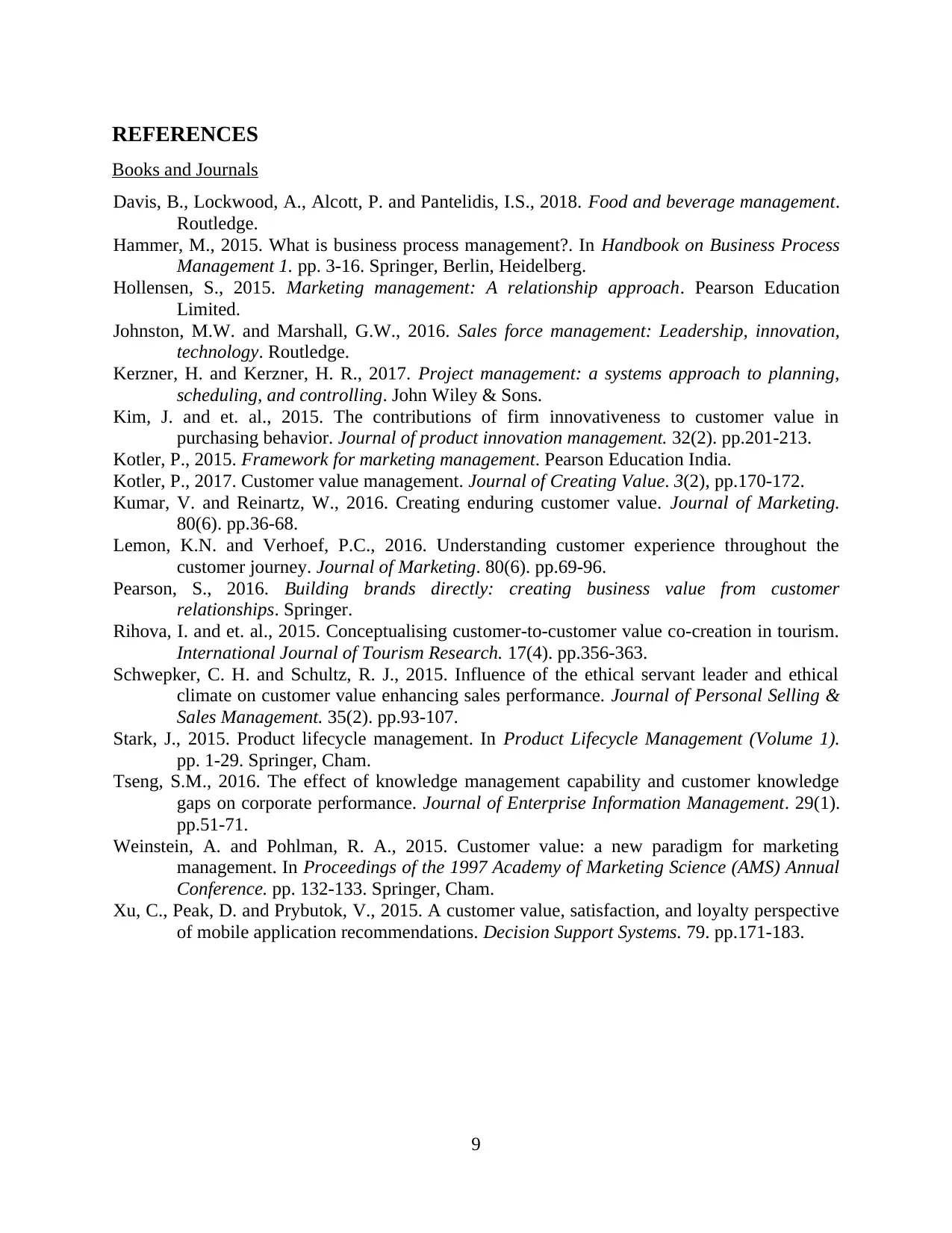
REFERENCES
Books and Journals
Davis, B., Lockwood, A., Alcott, P. and Pantelidis, I.S., 2018. Food and beverage management.
Routledge.
Hammer, M., 2015. What is business process management?. In Handbook on Business Process
Management 1. pp. 3-16. Springer, Berlin, Heidelberg.
Hollensen, S., 2015. Marketing management: A relationship approach. Pearson Education
Limited.
Johnston, M.W. and Marshall, G.W., 2016. Sales force management: Leadership, innovation,
technology. Routledge.
Kerzner, H. and Kerzner, H. R., 2017. Project management: a systems approach to planning,
scheduling, and controlling. John Wiley & Sons.
Kim, J. and et. al., 2015. The contributions of firm innovativeness to customer value in
purchasing behavior. Journal of product innovation management. 32(2). pp.201-213.
Kotler, P., 2015. Framework for marketing management. Pearson Education India.
Kotler, P., 2017. Customer value management. Journal of Creating Value. 3(2), pp.170-172.
Kumar, V. and Reinartz, W., 2016. Creating enduring customer value. Journal of Marketing.
80(6). pp.36-68.
Lemon, K.N. and Verhoef, P.C., 2016. Understanding customer experience throughout the
customer journey. Journal of Marketing. 80(6). pp.69-96.
Pearson, S., 2016. Building brands directly: creating business value from customer
relationships. Springer.
Rihova, I. and et. al., 2015. Conceptualising customer‐to‐customer value co‐creation in tourism.
International Journal of Tourism Research. 17(4). pp.356-363.
Schwepker, C. H. and Schultz, R. J., 2015. Influence of the ethical servant leader and ethical
climate on customer value enhancing sales performance. Journal of Personal Selling &
Sales Management. 35(2). pp.93-107.
Stark, J., 2015. Product lifecycle management. In Product Lifecycle Management (Volume 1).
pp. 1-29. Springer, Cham.
Tseng, S.M., 2016. The effect of knowledge management capability and customer knowledge
gaps on corporate performance. Journal of Enterprise Information Management. 29(1).
pp.51-71.
Weinstein, A. and Pohlman, R. A., 2015. Customer value: a new paradigm for marketing
management. In Proceedings of the 1997 Academy of Marketing Science (AMS) Annual
Conference. pp. 132-133. Springer, Cham.
Xu, C., Peak, D. and Prybutok, V., 2015. A customer value, satisfaction, and loyalty perspective
of mobile application recommendations. Decision Support Systems. 79. pp.171-183.
9
Books and Journals
Davis, B., Lockwood, A., Alcott, P. and Pantelidis, I.S., 2018. Food and beverage management.
Routledge.
Hammer, M., 2015. What is business process management?. In Handbook on Business Process
Management 1. pp. 3-16. Springer, Berlin, Heidelberg.
Hollensen, S., 2015. Marketing management: A relationship approach. Pearson Education
Limited.
Johnston, M.W. and Marshall, G.W., 2016. Sales force management: Leadership, innovation,
technology. Routledge.
Kerzner, H. and Kerzner, H. R., 2017. Project management: a systems approach to planning,
scheduling, and controlling. John Wiley & Sons.
Kim, J. and et. al., 2015. The contributions of firm innovativeness to customer value in
purchasing behavior. Journal of product innovation management. 32(2). pp.201-213.
Kotler, P., 2015. Framework for marketing management. Pearson Education India.
Kotler, P., 2017. Customer value management. Journal of Creating Value. 3(2), pp.170-172.
Kumar, V. and Reinartz, W., 2016. Creating enduring customer value. Journal of Marketing.
80(6). pp.36-68.
Lemon, K.N. and Verhoef, P.C., 2016. Understanding customer experience throughout the
customer journey. Journal of Marketing. 80(6). pp.69-96.
Pearson, S., 2016. Building brands directly: creating business value from customer
relationships. Springer.
Rihova, I. and et. al., 2015. Conceptualising customer‐to‐customer value co‐creation in tourism.
International Journal of Tourism Research. 17(4). pp.356-363.
Schwepker, C. H. and Schultz, R. J., 2015. Influence of the ethical servant leader and ethical
climate on customer value enhancing sales performance. Journal of Personal Selling &
Sales Management. 35(2). pp.93-107.
Stark, J., 2015. Product lifecycle management. In Product Lifecycle Management (Volume 1).
pp. 1-29. Springer, Cham.
Tseng, S.M., 2016. The effect of knowledge management capability and customer knowledge
gaps on corporate performance. Journal of Enterprise Information Management. 29(1).
pp.51-71.
Weinstein, A. and Pohlman, R. A., 2015. Customer value: a new paradigm for marketing
management. In Proceedings of the 1997 Academy of Marketing Science (AMS) Annual
Conference. pp. 132-133. Springer, Cham.
Xu, C., Peak, D. and Prybutok, V., 2015. A customer value, satisfaction, and loyalty perspective
of mobile application recommendations. Decision Support Systems. 79. pp.171-183.
9
1 out of 11
Related Documents
Your All-in-One AI-Powered Toolkit for Academic Success.
+13062052269
info@desklib.com
Available 24*7 on WhatsApp / Email
![[object Object]](/_next/static/media/star-bottom.7253800d.svg)
Unlock your academic potential
Copyright © 2020–2025 A2Z Services. All Rights Reserved. Developed and managed by ZUCOL.





